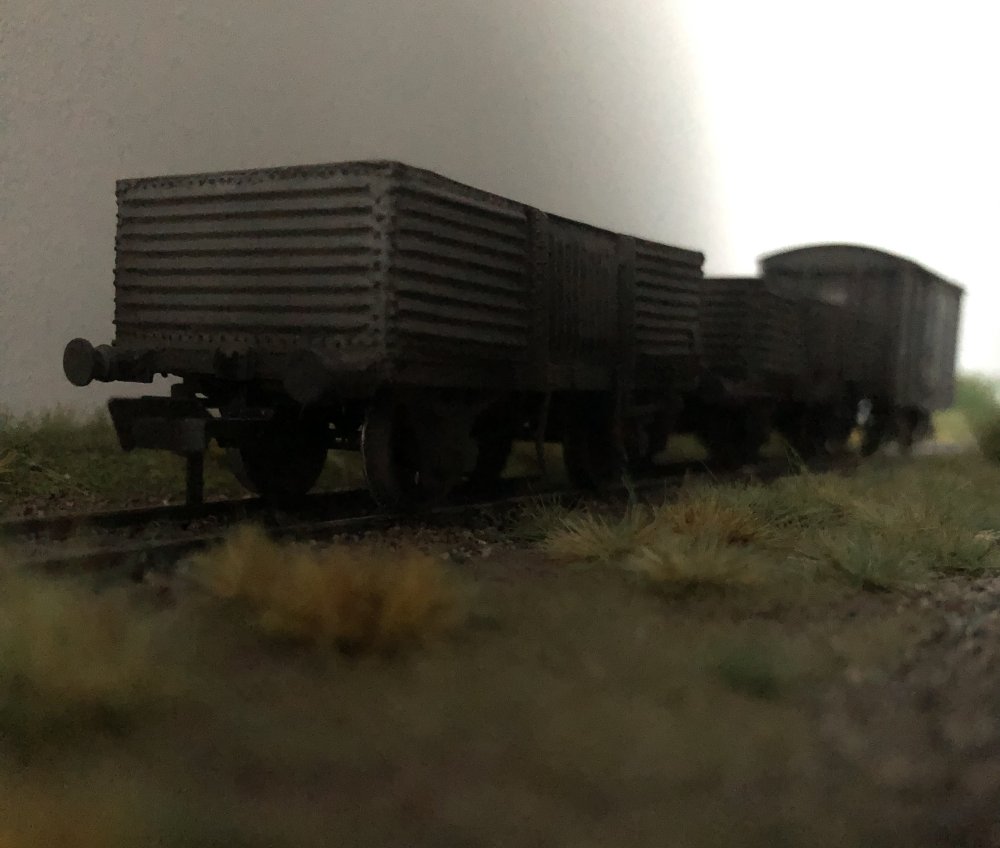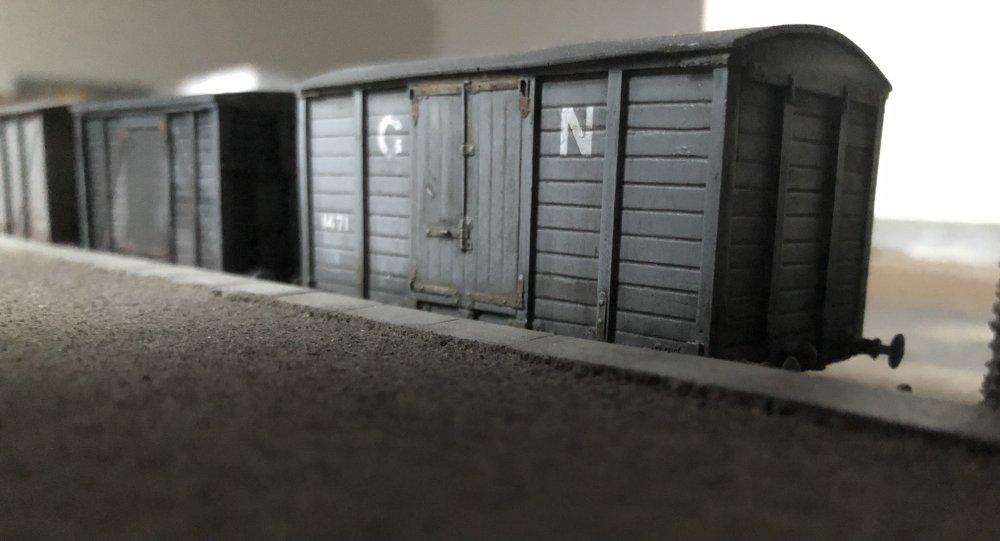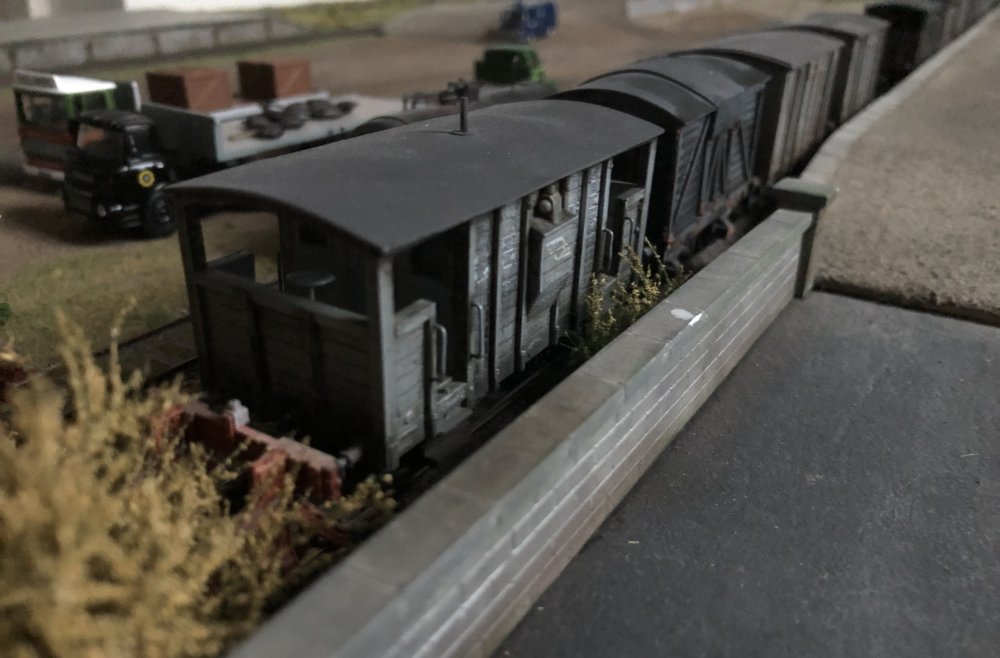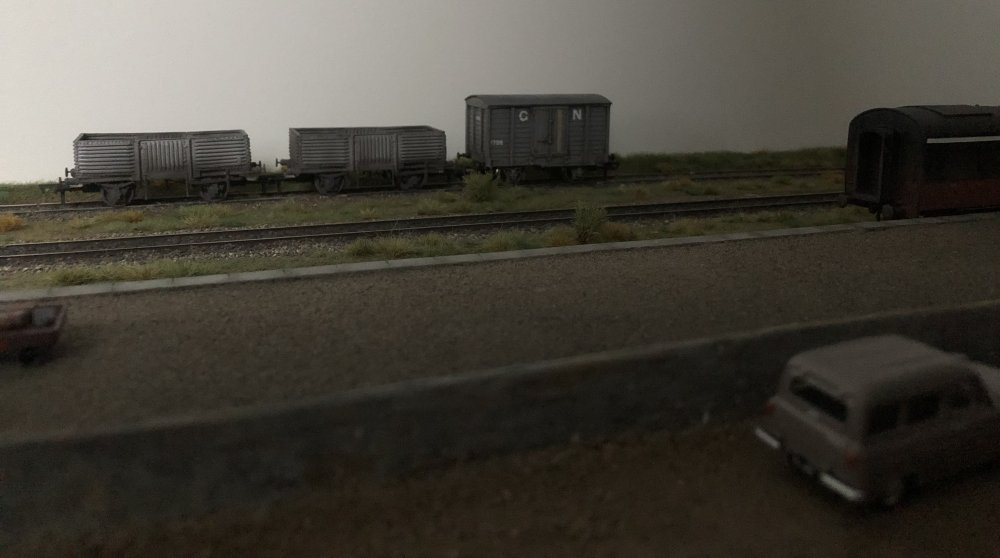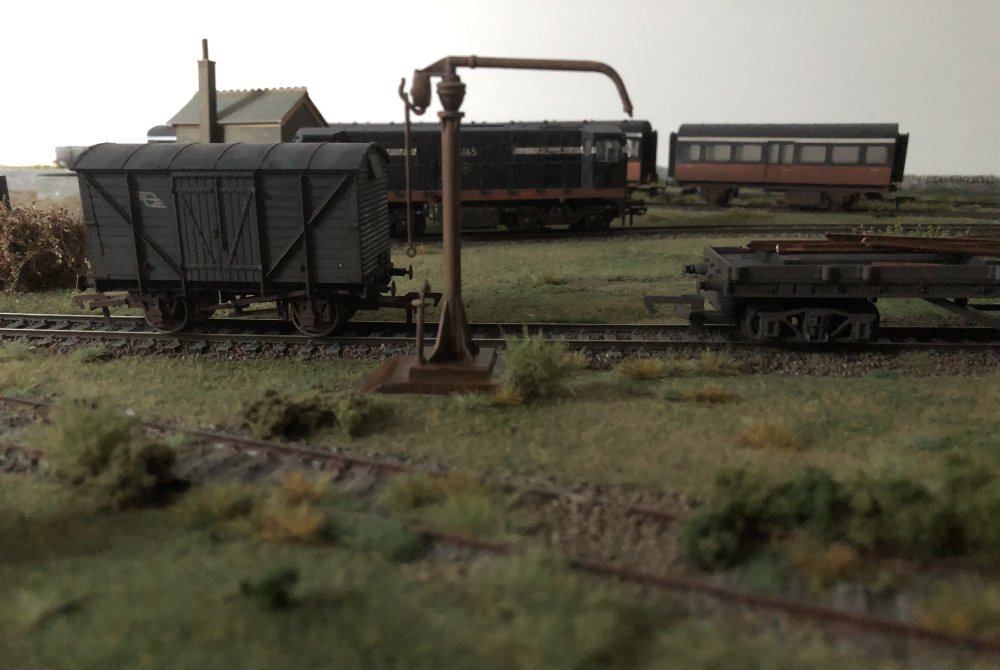-
Posts
15,822 -
Joined
-
Last visited
-
Days Won
393
Content Type
Profiles
Forums
Events
Gallery
Blogs
Store
Community Map
Everything posted by jhb171achill
-
Yes - educational indeed! One of its many "wow factor" qualities.
-
Looks just like a Harold Fayle photo found in the depths of the IRRS' catacombs!
-
Wow! Yet another masterpiece! The scenery, the rolling stock, the setting, the concept; absolutely perfect stuff.
-
Hypothetically they could, yes; albeit with some adjustment, perhaps, to various connections. The De Deitrichs are actually an adaptation of a design originally intended for electric haulage. However, as others suggest, I believe the future of railways here is hybrids at least, or more likely in the very long term, once the technology is suitable, battery-electric. Dr. Drumm was WAY ahead of his time. Distances in Ireland are short by international standards. Freight traffic is small, and since these trains operate in almost permanently fixed formations, battery-electric freight multiple units would seem to be the logical way forward - and that's if there will be any freight at all in the future. Despite all the fine talk, the NTA's attitude to rail freight seems to be a carbon copy of the UTA in the 1960s. NTA, UTA, same. Thus, expect to see the Irish Rail network in years to become as NIR is now, has been, and will be for evermore. Amen. Railcar heaven; a 5 fut 3 Luas. Maintenance by increasingly sophisticated yellow things, rather than loco-hauled maintenance trains. Therefore, I agree with the post above that the 071s and 201s will carry on, probably until the last of them falls to bits or they can't get spare parts. I doubt there will be a new fleet of locos of any hue, to be honest. Not complaining or praising such an idea; just stating what appears to me to be the obvious, whether any of us like it or not......... an evolving modern railway is better than none at all.
-
All is quiet on a September evening at dusk at Dugort Harbour in 1965. The sky is about to empty. Nobody about until the morning, but our gricer photographer has free reign - the gates lie open all the time, as they have done for years. The night watchman is at home listening to the wireless, the kettle simmering on the range. Tomorrow, B165 will assemble a short goods train and head up to town.
-
If it’s 1910-30, the livery is easy - plain grey locos, no lining (or lined black, a la LNWR). Carriages a very dark brown brownish maroon - the LMS-style maroon didn’t appear until the mid-30s.
-
A fascinating period indeed - I wish you the very best with it. What size is your table?
-
Gotta be Fintona!
-
Those look perfect!
-
What scale is it? I'll be slaughtered by traditionalists, but I quite like that model.........
-
A pretty good model for its day; its rejuvenation will be a great job - especially in your hands!
-
Worth adding, when jhb171Senior was in Enniskillen, he was very friendly with both the SLNCR's general manager (G W Egan) & Traffic Manager (E W Mongahan). The latter was perpetually sorely embarrassed by the state of their passenger stock and preferred the railcar (B). The old railbuses were clapped out too and to Monaghan equally embarrassing! As a result, at every opportunity he could, if there was a loco-hauled special, he would prefer to borrow equally elderly ex-MGWR six-wheelers from CIE in Sligo, as they were better looked after and more presentable to the public, or an elderly bogie or two from the GNR's spare stock at Clones! As it happens, I am unaware of any CIE bogie stock, let alone corridor stock, ever traversing the line. There's a nice shot in one of Charles Friel's books of an excursion arriving in Enniskillen off the SLNCR with two MGWR 6-wheelers (in CIE green) in the midst of it. So Enniskillen did see its "flying snails" on more than wagons! A few more years and who knows - a Crossley or Sulzer diesel?
-
I love the "distressed maroon" on the coach! In later years, there were three categories of "livery" on at least two of their coaches - bare, faded bleached wood where all paint had long peeled off, and damp was getting into the timber; twenty layers of dull brake dust; and what was left of the maroon paint, now faded to a nondescript pinkish-brown! There was just one coach which got a nice new coat of the dark maroon towards the end - one of the bogies. Great description of the 07:20, though why on earth there was black smoke while ON a gradient is a puzzle - any fireman worth his salt would have put on a fire going downhill, not uphill! That's an amazing model of the whole train - it captures the down-at-heel look of the railway in its later days perfectly. It would be interesting to see a decent selection of pictures of when everything was pristine and new, though it didn't last long. Yes, a layout is needed now!
-
Very nice!!
-
A few observations on your initial post: "....I’ve read that GSWR cars were painted, at various times, purple, grey, light brown and green. So I was hoping my life would be easy and I could just get Hornby GWR brown/cream coaches or the GSR green coaches...." The "purple" was actually the "crimson lake" I mentioned above rather than actual puyrple, as such; see pics of coach 836 at Downpatrick. The RPSI have two coaches restored that way too - 1142 & 351; but not on display. Wagons were grey, not carriages. Nothing on the GSWR in the way of rolling stock was ever light brown or green, though locomotives were green as described above prior to 1900. Those Hornby bogies you mention - again, not like GSWR types, though with a flat roof fitted instead of the clerestorey they come with, bear more than a passing resemblance to two Waterford, Limerick & Western vehicles which actually ended up in GSWR hands. Green on coaches (and some locos) was used by CIE rather than the GSR, whose carriages were maroon latterly; green on coaches therefore post-dates the GSWR by twenty years. However, if like me, you chose to model a FORMER GSWR line as it would hve been in the 1950s, then one of the two CIE green liveries is yer only man.
-
Hi Johnny, and a very warm welcome here - you'll find all sorts of people with all manner of good advice from technical to model availability to historical to everything else. The major Irish model manufacturers and retailers also are online here. Good to hear you're modelling the GSWR - a masively neglected topic, given that it was the biggest and at one time most advanced railway company on this island. Your choice of loco is fine given the circumstances you're dealing with, and the Hattons (or Hornby) six-wheelers are by far what you want. So you want to model Co Kerry (my own layout is based there too, but in CIE days). Your first question relates toi train make-up. If you look at a typical train on a main secondary line, like Mallow - Waterford, Mallow-Tralee or Tralee-Limerick, you'll be more likely to have one or two bogies coaches among six-wheelers, but if you're looking at Valentia, Kenmare, Newmarket or Mitchelstown, or before 1930 Castleisland or Fenit, a typical passenger vtrain had to cater for mail, the guard, luggage and passengers of 1st, 2nd and 3rd classes. A typical passenger train makeup might therefore be - first, second, one or two thirds, and a passenger brake which was either a full brake (two double doors and guard in the middle) or a brake third (one or two third class compartments with a smaller luggage area and guard's van in it. On branch lines - and even the secondary main lines mentioned above, many trains were mixed. Trains to places like Fenit, Castleisland, Kenmare and several others were mostly mixed, or indeed ALL mixed. that means that you'd have the above passenger consist behind the locomotive, followed by whatever goods wagons there were on the day (more of which later) and finally a guards van, as almost no non-passenger vehicles were vacuum brake fitted. So, the goods wagons. Go to Britain and you've rural trains back then with milk tankers, slate wagons, coal and coke wagons, and all sorts of stuff. Here' things were simpler; we have no heavy industry, so don't make the mistake of copying a train consist shown on the front of a Hornby box. The vast majority of wagons in trains here consisted of various ages and designs of the humble covered van; in GSWR days a majority of these were the very Irish "soft-top"; that is, a goods van with the roof divided into three thirds; the end sections being hard roof, the middle section open. To carry dry goods, a tarpaulin was secured over the opening, hence the nickname gfiven by railwaymen, "soft-top". When they were used for cattle, as they were, the tarp was off to provide ventilation. Second numerically were actual cattle wagons, because on many rural lines especially in West Cork, Kerry and the west of Ireland in general, cattle traffic was by far the biggest form of railway traffic there was. Monthly cattle fairs were huge, some loading several hundred wagons with "beasts" in a 48 hour period and leading to many cattle specials being operated. Third - plain bog standard open wagons, which carried just about anything. The guard's van at the back, of course, is entirely obligatory until fitted trains appear in the late 1960s. A goods train before that without a van on the end is as utterly incomplete as any train with no locomotive, or as realistic as a train hauled by a clockwork unicorn. Your little Hornby 4-wheelrs are a good start; they're certainly better than a 1960s BR Mk 1 repainted into any livery! You mention liveries. Let's deal with locos first. The GSWR had broadly three livery "eras". Prior to about 1900/01/02, all locomotives were a very dark olive green; a sample may be seen in the Malahide Model Railway Museum, which contains a treasure trove of accurate old liveries. Lining was elaborate. Originally, it was red, black, yellow and light green; later red and black, later cream and black - but all this is prior to 1900, for which you'd be looking at more scratchbuilding of stock, in all reality. In 1900 or so, they started painting locos a shiny black with red and white lining. Note - not light grey and red like BR, nor beige and red like the UTA; red and white. Some locos seemd to have mostly red. In 1915 they started painting locos all-over dark grey - the whole loco, smokebox, chimney, wheels, motion and all. No markings whatsoever, no lining - dull as ditchwater, but VERY easy to model! This livery not only outlasted the GSWR, but also its successor, the GSR, lasting on CIE on most locomotives until their replacement by diesels when steam ended in 1962. As far as wagons were concerned, these appear to all have been either an extremely dark grey or black until the early years of the 20th century, when a mid to dark grey appeared; lettering in all cases was white. Metalwork and chassis were also the same as body colour. Passenger vehicles were more uniform from the earliest days. Certainly by the 1880s, an extremely dark brownish maroon called "crimson lake" was introduced, so dark that in traffic it could almost look black - a bit like Guinness; hold a pint of that to the light, and it's not black - it's RED! Lining on these vehicles was elaborate with gold leaf, red and black used initially, later simplified to gold paint. It is possible that pale yellow paint was used as an economy measure during the forst world war, as on some other lines (e.g. the BCDR & MGWR) who also used gold lining. This carriage colour remained until 1925 when the GSWR became part of the GSR; like the grey loco livery, the GSWR "crimson lake" remained in use (albeit with different markings) by the GSR for some years more. The GSWR crest was typically carried once each side of 6-wheelers, and twice on each side of a bogie coach. In 1906, the GSWR introduced a new express train, with new purpose-built carriages, for the Cork - Rosslare "Rosslare Express". These had the same basic livery but cream upper panels. Concurrent with the new lined black loco livery, these cream panels soon spread to other main line stock, but never to secondaery or branchline stock, which retained the all-over crimson lake. I don't know what they were smoking in the paint labs in Inchicore when they dreamed up the name "crimson lake"; I've never seen a lake the colour of Guinness and if I did, I'd be hesitant to swim in it, let alone drink it.... So, where do we reference these liveries? The grey loco livery, by far the longest lasting, may be seen on the RPSI's J15 / 101 class No. 186 in Whitehead Museum. This was applied in the 1990s and several folks were still alive at the time who remembered the real thing - they said it was accurate. Just as well, as after considerable research it was matched with an actual sample. See it before they repaint this thing; apart from No. 4 and GNR locos, the RPSI's track record of loco livery accuracy is, well.......... OK; changing the subject: There is one model in the Cyril Fry collection in Malahide in the grey too. The coach livery is very beautifully and accurately portrayed on the Downpatrick & Co Down Railway's ex-GSWR third No. 836, in the museum at Downpatrick - this museum is a must as it also contains ex-GSWR No. 90, the 0.6.0T built for the Castleisland line - it is in full, accurately lined pre-1895 GSWR olive green livery. If you want to go back that far, you MUST go to see these two. Mid / dark grey for wagons. If you can't visit these places, look up their websites and you'll see photos of the vehicles mentioned. So, how do you model all of this on the cheap? An imaginary Kerry branchline will have a train of three to four coaches plus maybe half a dizen wagons and a guard's van on the end. If it is four coaches, there's a first, second and two thirds and a full brake, or a first, second third and brake third. Not exact science; the odd day and extra third, another day a single coach with 1st & 2nd compartments instead of a full coach for each. They had a few 1st / 3rd coaches; as long as there's accommodation for Lord & Lady Muck, and the Marquis of Ballygobackwards in 1st, the town gombeen man and the "gentleman farmer", and the bowler-hatted commercial traveller in 2nd, and the Plebs and the Great Unwashed in 3rd, that's fine. The train had accommodation for all three. Boxes of hens and fish in the van, please, not in here. There were four wheelers in use until the early 1880s, but of a design not anything remotely similar to any British 4-wheelers. Thus, the Ratio 4-wheel kits are far, far too long, as are the Hornby / Hattons ones. Go for their SIX wheelers. There is nothing whatsoever on the market that is even close to any type of GSWR bogie coach, unfortunately. Inchicore's designs were far too elegant for model manufacturers! So stick with your existing four wheelers for economy, but get half a dozen Hornby 6 wheelers as time and funds permit; i think they're about €40 or so. Check Mark's Models in Cork - if they haven't got any, they'll order them. They had them in Greenogue at one stage. If you buy them from Britain, you'll be crucified with VAT, Boris tax, Brexit fees, and gawd knows what else; possibly exceeding the value of the thing. Wagons - there's only one show in town. You'll need "soft-tops". You can get kits from Studio Scale Models in Ennis. Whitemetal and a bit heave, but a good model. The GSWR guards van was very distinctive, so again, only one show in town: Provincial Models - check out Leslie McAllister's presence on here; he is the "Provincial One". Leslie also does a nice kit of a GNR goods van which isn't a million miles away from early designs of GSWR vans. Check out JM Design of New Zealand on this site too - he does several GSWR van types of later (post-1900) times. Buy cheap Hornby / Bachmann five-plank open wagons and drown them in a pot of grey paint. That lot above is just off the top'o'me'head; I have to walk the Elder Canine Person now or else he'll leave a present on the carpet, and I've a mountain of emails to answer. However, keep the questions coming, and if I think of anything else I'll come back here.
-
Brookhall Mill - A GNR(I) Micro Layout
jhb171achill replied to Patrick Davey's topic in Irish Model Layouts
If the UTA have anything to do with it, it'll be buses! -
I doubt that my five month old gransdon will see it completed......... unless the NTA and Fine Gael cease to be..............
-
Brookhall Mill - A GNR(I) Micro Layout
jhb171achill replied to Patrick Davey's topic in Irish Model Layouts
Jayyyysus, Weaver, don't jump!!! -
Very probably; can't think of any others, unless one counts the platform subway at Ballymena which some NG passengers would have used......
-
Fascinating stuff - worth a lot of browsing. Not too much railway in it, but glimpses of wagons (and early carriages) on the quays here and there. A book on the railways of the port and the interconnecting Dublin lines would be a must-read, but the amount of research needed to cover it even half-adequately would be daunting in the extreme!
-
Yes, it was indeed the only double track line on the Irish narrow gauge; fully so, signalled as such, etc., despite being singled shortly after the GSR took over. It was also the fastest, and the only narrow gauge commuter railway; three "unique" qualities on this short, and short-lived line. Perfect site for a CLUAS these days.
-
Next it'll be bloooo passports, and sunny uplands.............
-
Fastest narrow gauge engines in Ireland, even beating the NCC ones. I understand they could reach 50mph. They certainly LOOK as though they could!
-
Brookhall Mill - A GNR(I) Micro Layout
jhb171achill replied to Patrick Davey's topic in Irish Model Layouts
Those interiors are superb. Inspiring me to get on with my own buildings - if I can find where I have all the bits and pieces after last house move 2 years ago! After all, there has to be an office at Dugort Harbour to deal with the paperwork related to incoming GNR vans from Brookhall in the north, with linen consignments!
.png.c363cdf5c3fb7955cd92a55eb6dbbae0.png)





